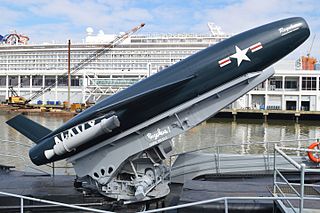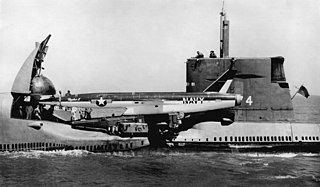Arizona has been the name of three ships of the United States Navy and will be the name of a future submarine.
USS Scorpion may refer to:
USS Seawolf may refer to:

The SSM-N-8A Regulus or the Regulus I was a United States Navy-developed ship-and-submarine-launched, nuclear-capable turbojet-powered second generation cruise missile, deployed from 1955 to 1964. Its development was an outgrowth of U.S. Navy tests conducted with the German V-1 missile at Naval Air Station Point Mugu in California. Its barrel-shaped fuselage resembled that of numerous fighter aircraft designs of the era, but without a cockpit. Test articles of the Regulus were equipped with landing gear and could take off and land like an airplane. When the missiles were deployed they were launched from a rail launcher, and equipped with a pair of Aerojet JATO bottles on the aft end of the fuselage.
At least seven United States Navy ships have been named Alabama, after the southern state of Alabama.
Several United States Navy ships have borne the name Florida, in honor of the state of Florida:
One ship and one submarine of the United States Navy have been named USS New Mexico in honor of the state of New Mexico.
USS Colorado may refer to:
Four ships of the United States Navy have been named USS Indianapolis:

USS John A. Moore (FFG-19), eleventh ship of the Oliver Hazard Perry class of guided-missile frigates, was named for Commander John Anderson Moore (1910–1944). Ordered from Todd Pacific Shipyards, Los Angeles Division, San Pedro, California on 28 February 1977 as part of the FY77 program, John A. Moore was laid down on 19 September 1978, launched on 20 October 1979, and commissioned on 14 November 1981.

USS Grayback (SS/SSG/APSS/LPSS-574), the lead ship of her class of submarine, was the second ship of the United States Navy to be named for the grayback.

USS Growler (SSG-577) was an early attempt by the U.S. Navy to field a cruise missile submarine that would provide a nuclear deterrent using its second series of cruise missiles. Built to deliver the Regulus I cruise missile, Growler was the second and final submarine of the Grayback class, fourth ship of the United States Navy to be named after the growler. Since Regulus I and Regulus II programs had problems, Growler and Grayback were the only two submarines built in this class as instead, the U.S. Navy veered its nuclear deterrence efforts into submarine launched ballistic missiles (SLBMs)—the Polaris missile program.
A cruise missile submarine is a submarine that carries and launches cruise missiles as its primary armament. Missiles greatly enhance a vessel's ability to attack surface combatants and strike land targets, and although torpedoes are a more stealthy option, missiles give a much longer stand-off range, as well as the ability to engage multiple targets on different headings at the same time. Many cruise missile submarines retain the capability to deploy nuclear warheads on their missiles, but they are considered distinct from ballistic missile submarines due to the substantial differences between the two weapons systems' characteristics.

USS Grampus (SS-207), a Tambor-class submarine, was the sixth ship of the United States Navy to be named for a member of the dolphin family (Delphinidae): Grampus griseus, also known as Risso's dolphin.
USS Grayling has been the name of more than one United States Navy ship, and may refer to:

USS Grayback (SS-208), a Tambor-class submarine, was the first ship of the United States Navy to be named for the lake herring, Coregonus artedi.
Three submarines of the United States Navy have been named USS Barb, named after the fish, may refer to:

The Grayback-class submarine was a class of two guided missile-carrying submarines of the United States Navy. They carried the Regulus I and Regulus II nuclear cruise missiles, deployed 1957–64, that were rapidly phased out by Polaris Submarine Launched Ballistic Missiles (SLBMs). They and USS Halibut were the sole submarines designed specifically to carry Regulus missiles, and the only submarines capable of carrying Regulus II. However, USS Tunny and USS Barbero were modified earlier to carry two Regulus I missiles per boat.

The Regulus missile submarines were a group of submarines operated by the United States Navy capable of carrying the Regulus cruise missile. Between 1959 and 1964, a total of five boats were used to undertake the first submarine-based nuclear deterrent patrols by the United States. Regulus submarines were used for this task until 1964, when sufficient ballistic missile submarines carrying the Polaris ballistic missile became available.
This page is based on this
Wikipedia article Text is available under the
CC BY-SA 4.0 license; additional terms may apply.
Images, videos and audio are available under their respective licenses.






